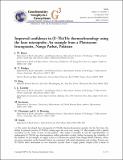| dc.contributor.author | Boyce, J. W. | |
| dc.contributor.author | Hodges, Kip Vernon | |
| dc.contributor.author | King, D. | |
| dc.contributor.author | Crowley, J. L. | |
| dc.contributor.author | Jercinovic, M. | |
| dc.contributor.author | Chatterjee, Nilanjan | |
| dc.contributor.author | Bowring, Samuel A. | |
| dc.contributor.author | Searle, M. | |
| dc.date.accessioned | 2012-09-28T17:09:03Z | |
| dc.date.available | 2012-09-28T17:09:03Z | |
| dc.date.issued | 2009-09 | |
| dc.date.submitted | 2009-03 | |
| dc.identifier.issn | 1525-2027 | |
| dc.identifier.uri | http://hdl.handle.net/1721.1/73482 | |
| dc.description.abstract | The newly developed laser microprobe (U-Th)/He thermochronometer permits, for the first time, the ability to generate precise (U-Th)/He cooling ages for even very young (<1 Ma) samples with a spatial resolution on the order of tens of micrometers. This makes it possible to test the reproducibility of independent (U-Th)/He age determinations within individual crystals, further increasing the reliability of the method. As an example, we apply it here to a Pleistocene granite from Nanga Parbat, Pakistan, where previous constraints on the thermal history are consistent with rapid exhumation and cooling. Twenty-one (U-Th)/He dates determined on two monazite crystals from a single granite sample yield a mean of 748,000 years with a ∼95% confidence level of ±19,000 years. There is no discernible variation in the distribution of (U-Th)/He ages in the cores of these crystals and therefore no evidence for the development of substantial diffusive-loss 4He zoning over 80% of the interior of the monazite crystals during postcrystallization cooling of the granite. Modeling of these data suggests that cooling at a mean rate of ∼300 K/Ma would be necessary to produce the observed ages and the lack of a 4He gradient, which is consistent with preexisting constraints for Nanga Parbat. Increased precision in thermochronology permits more tightly constrained exhumation models, which should aid geologic interpretation. | en_US |
| dc.description.sponsorship | National Science Foundation (U.S.) | en_US |
| dc.language.iso | en_US | |
| dc.publisher | American Geophysical Union (AGU) | en_US |
| dc.relation.isversionof | http://dx.doi.org/10.1029/2009gc002497 | en_US |
| dc.rights | Article is made available in accordance with the publisher's policy and may be subject to US copyright law. Please refer to the publisher's site for terms of use. | en_US |
| dc.source | MIT web domain | en_US |
| dc.title | Improved confidence in (U-Th)/He thermochronology using the laser microprobe: An example from a Pleistocene leucogranite, Nanga Parbat, Pakistan | en_US |
| dc.type | Article | en_US |
| dc.identifier.citation | Boyce, J. W. et al. “Improved Confidence in (U-Th)/He Thermochronology Using the Laser Microprobe: An Example from a Pleistocene Leucogranite, Nanga Parbat, Pakistan.” Geochemistry Geophysics Geosystems 10.9 (2009). Copyright 2009 by the American Geophysical Union | en_US |
| dc.contributor.department | Massachusetts Institute of Technology. Department of Earth, Atmospheric, and Planetary Sciences | en_US |
| dc.contributor.mitauthor | Boyce, J. W. | |
| dc.contributor.mitauthor | Hodges, Kip Vernon | |
| dc.contributor.mitauthor | Crowley, J. L. | |
| dc.contributor.mitauthor | Chatterjee, Nilanjan | |
| dc.contributor.mitauthor | Bowring, Samuel A. | |
| dc.relation.journal | Geochemistry Geophysics Geosystems | en_US |
| dc.eprint.version | Final published version | en_US |
| dc.type.uri | http://purl.org/eprint/type/JournalArticle | en_US |
| eprint.status | http://purl.org/eprint/status/PeerReviewed | en_US |
| dspace.orderedauthors | Boyce, J. W.; Hodges, K. V.; King, D.; Crowley, J. L.; Jercinovic, M.; Chatterjee, N.; Bowring, S. A.; Searle, M. | en |
| dc.identifier.orcid | https://orcid.org/0000-0001-9722-469X | |
| mit.license | PUBLISHER_POLICY | en_US |
| mit.metadata.status | Complete | |
